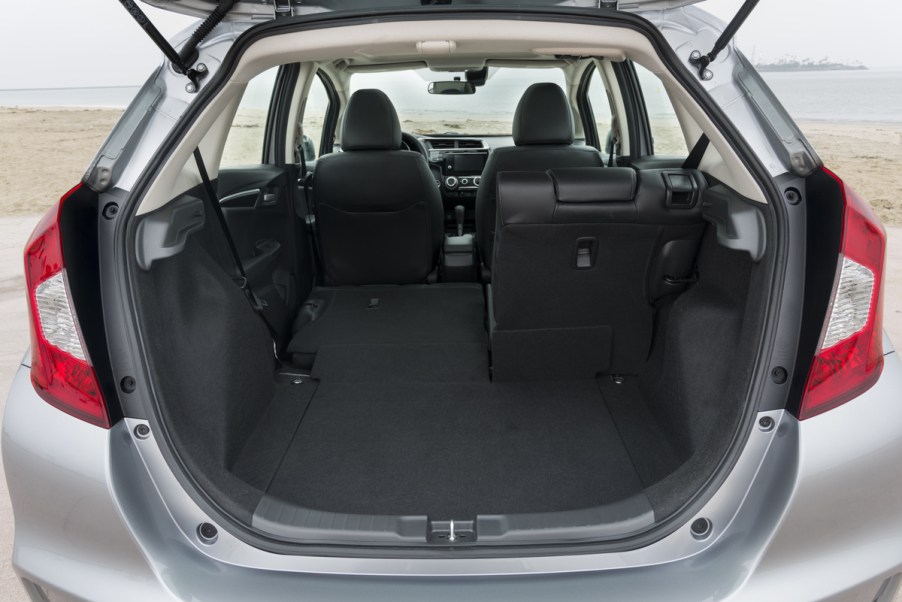
1 Discontinued Honda Hatchback Has More Interior Space Than a Jeep Renegade Compact SUV
In this article:
While the majority of modern cars have rounded shapes, that doesn’t mean that there’s anything wrong with square vehicles. On the contrary, these cars often have the most functional cargo areas because of their higher ceiling heights. However, when comparing the Honda Fit hatchback and Jeep Renegade, we found out that appearances can be deceiving.
How big is the Honda Fit inside?
From a glance, it looks like the majority of the Honda Fit hatchback is composed of its bulbous front end. This design creates a welcome space for rear seat passengers with over 39 in of legroom and 37 in of headroom. The cabin is slightly bigger with about 2 extra inches in each measurement. Its elongated windshield also provides extra visibility and makes the cabin feel bigger than it actually is.
Cargo accommodations are just as satisfying for a car of this size. The Honda Fit is a hatchback with nearly 17 cubic feet of storage area available behind the rear seats. Every Honda Fit also has a 60/40 split-folding rear seat with Magic Seat technology, providing several different cargo configurations. The front passenger seat practically reclines to the floor, giving the rear right-side passenger a long legrest if desired. If you choose to fold all the rear seats flat to the floor, you’ll get nearly 53 cubes of cargo space.
The Jeep Renegade has less interior space
At about 51 cubes, the 2020 Jeep Renegade’s total cargo capacity slightly trails behind the 2020 Honda Fit’s. Behind the rear seat, you’ll have access to over 18 cubes worth of storage space. However, critics on U.S. News complained that the Renegade’s cargo area feels too confining.
The Jeep Renegade is a bit longer than the Honda Fit, yet rearseat passengers only get 35 in of legroom. It’s clear that the Renegade’s design favors the cabin occupants, who receive 41 in of both legroom and headroom. While the Renegade has seating for five, one review suggests that only two riders will fit comfortably in the second row.
The Jeep Renegade has never had a redesign, so 2023 models will have just as much cargo capacity as the one from 2020. The Jeep Renegade also fails to live up to the potential of its boxy counterparts, such as the Kia Soul. Even though the seats don’t fold quite as flat as the Renegade’s, the Kia Soul has 62 cubes of total storage area. 24 cubes can be utilized behind the second row, which is nearly on par with the Honda Fit in terms of legroom.
Between the Jeep Renegade and Honda Fit, the Honda hatchback receives the highest interior quality score on U.S. News. it only has a few plastic panels inside, which is outstanding for a car that retailed at $16,190. The Jeep Renegade’s interior score has improved slightly over the years, but it’s still adorned with many hard surfaces. Splashes of color liven up the interior of the 2020 Renegade, though they look slightly out of place compared to the Honda Fit’s silvery accents. On the plus side, critics found the Renegade’s interior components durable and didn’t detect any fitting issues.
Why was the Honda Fit discontinued?
Car and Driver tells us that the Honda Fit was discontinued due to sluggish sales in the subcompact car segment. However, because the Honda Fit is still popular in Asian countries and Europe, it still lives on in those markets. It even has a Crosstar SUV variant with additional body cladding, roof rails, and heightened ground clearance.
Both the Honda Fit and its Crosstar variant still have the Magic Seat for ease of managing groceries or weekend getaway gear. If you’re in the U.S., it’s easy to find a Honda Fit on the used market. While its average asking price has increased to $20,000, a Honda Fit is still nearly $10,000 cheaper than a new Jeep Renegade.


